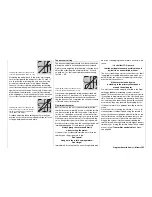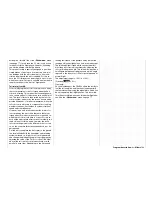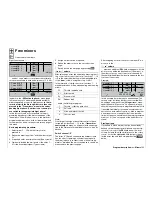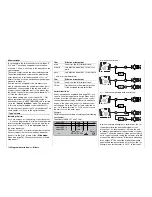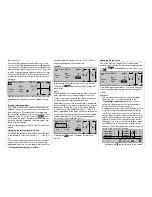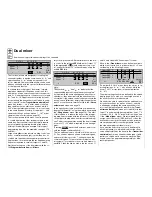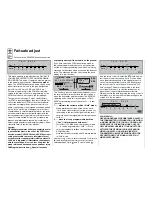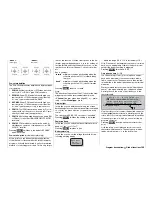
142
Program description:
Mixers
MIX active/phase
Mixers variable separately in fl ight phases
MIX-only channel
Separating control functions from control channels for each fl ight phase
LinearMIX
SEL
«Normal »
6
C1
8
S
EL
EL
10
EL
M I X A C T I V E I N P H A S E
no
yes
LinearMIX
LinearMIX
LinearMIX
yes
yes
1
2
3
4
Curve MIX
Curve MIX
Curve MIX
Curve MIX
SEL
«Normal »
??
X
Y
non
oui
??
??
??
??
??
oui
oui
M I X A C T I V E I N P H A S E
9
10
11
12
The “free mixers” of the previous menu can be disab-
led and activated separately in individual fl ight pha-
ses. You can therefore assign particular mixers to indi-
vidual fl ight phases without any restrictions.
Switch to the fl ight phase in question, and leaf
through this menu with the rotary control pressed in.
The mixers of the »
Free mixers
« menu are displayed
in the centre column.
If you select the
SEL
fi eld, give the rotary control a
brief press, and set the mixer in the right-hand co-
lumn to “no”, then it is switched off in the fl ight phase
displayed at the bottom, and will not appear in the list
in the »
Free mixers
« menu. If you “lose” a mixer from
the list, simply select the fl ight phases in turn until it
re-appears … alternatively move to this menu and
temporarily re-activate the mixer you are seeking.
M I X O N L Y C H A N N E L
MIXonly
normal
1 2 3
5 6 7 8 9
1112
4
10
In this menu you can interrupt the normal, direct sig-
nal fl ow between the
control function
on the input side
and the associated
control channel
at the output side,
i. e. you separate the “classic” connection between
transmitter control and servo.
A particular use of this facility of the
fl ight phase inde-
pendent
menu might be as a means of reliably kee-
ping one of the control channels 5 … 8 “free” in all
fl ight phases, as these channels can be assigned to
a transmitter control or switch for individual fl ight pha-
ses in the »
Transmitter control adjust
« menu.
Of course, the opposite is also possible: a stick, trans-
mitter control (CONTROL 5 … CONTROL 10) or
switch (SW 1 … 4, 7) which has, we might say, lost its
servo – perhaps in specifi c fl ight phases – can also
be used as a transmitter control in some other way;
for example, as described in the programming ex-
amples on the right, and on pages 173 and 182.
The stick, transmitter control (CONTROL 5 … CON-
TROL 10) or switch (SW 1 … 4, 7) which has “lost its
servo” after its channel was set to “MIX only” now only
acts on mixer inputs …
… and the servo connected to a channel set to “MIX
only” can also only be accessed by means of mixers
programmed to its control channel. That is why the
term “Mix only” (only available via mixers) is used to
describe this function.
If any channel is set to “Mix only”, it is then possible
to exploit both its control function and also its control
channel for any special functions you require –
com-
pletely independently of each other
; for more details
see the examples at the end of this section.
Using the rotary control, select channel 1 to 12 (
)
and give the rotary control a brief press to switch bet-
ween “MIX only” ( ) and “normal” ( ).
Typical setting:
1 2 3
5 6 7 8 9
1112
4
10
M I X O N L Y C H A N N E L
MIXonly
normal
Examples:
•
If you have a model glider which does not feature
airbrakes, the butterfl y (“crow”) function (see page
119) can be set up to act as a landing aid, opera-
ted by the C1 stick (for example), as is usual with
“normal” airbrakes. The (airbrake) servo normally
connected to channel 1 is now generally not pre-
sent, but receiver output 1 is still not “free”, as the
control signal of the brake stick is present at that
point.
In our particular case this control signal is not re-
quired, and can be de-coupled from control chan-
nel “1”, which “frees” it from the signal of the C1
stick. This is accomplished by setting channel 1 to
“MIX only” in the »
MIX only channel
« menu. It is
now possible to use control channel 1, and there-
fore also receiver socket 1, in any way for another
purpose by means of freely programmable mixers,
e. g. to control a speed controller.
•
In contrast, if your model features conventional air-
brakes and you wish to be able to try out the but-
terfl y (crow) system with and without the airbrakes
extended, then simply set C1 to “MIX only” and
program a free mixer “C1
C1”, in order to cont-
rol the airbrakes via servo 1. This mixer could then
be switched on and off by assigning a mixer switch
for the purpose.
Summary of Contents for mx-24s
Page 1: ...1...
Page 19: ...19 For your notes...
Page 35: ...35 For your notes...
Page 41: ...41 41 For your notes...
Page 57: ...57 For your notes...
Page 63: ...63 63 For your notes...
Page 69: ...69 69 For your notes...
Page 85: ...85 85 For your notes...
Page 99: ...99 For your notes...
Page 143: ...143 For your notes...
Page 191: ...191 For your notes...
Page 212: ...212 212 For your notes...
Page 213: ...213 213 For your notes...
Page 214: ...214 For your notes...
Page 216: ...216...




